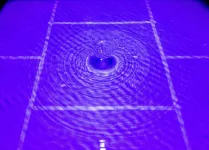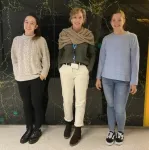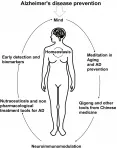(Press-News.org) An intelligent material that learns by physically changing itself, similar to how the human brain works, could be the foundation of a completely new generation of computers. Radboud physicists working toward this so-called "quantum brain" have made an important step. They have demonstrated that they can pattern and interconnect a network of single atoms, and mimic the autonomous behaviour of neurons and synapses in a brain. They report their discovery in Nature Nanotechnology on 1 February.
Considering the growing global demand for computing capacity, more and more data centres are necessary, all of which leave an ever-expanding energy footprint. 'It is clear that we have to find new strategies to store and process information in an energy efficient way', says project leader Alexander Khajetoorians, Professor of Scanning Probe Microscopy at Radboud University.
'This requires not only improvements to technology, but also fundamental research in game changing approaches. Our new idea of building a 'quantum brain' based on the quantum properties of materials could be the basis for a future solution for applications in artificial intelligence.'
Quantum brain
For artificial intelligence to work, a computer needs to be able to recognise patterns in the world and learn new ones. Today's computers do this via machine learning software that controls the storage and processing of information on a separate computer hard drive. 'Until now, this technology, which is based on a century-old paradigm, worked sufficiently. However, in the end, it is a very energy-inefficient process', says co-author Bert Kappen, Professor of Neural networks and machine intelligence.
The physicists at Radboud University researched whether a piece of hardware could do the same, without the need of software. They discovered that by constructing a network of cobalt atoms on black phosphorus they were able to build a material that stores and processes information in similar ways to the brain, and, even more surprisingly, adapts itself.
Self-adapting atoms
In 2018, Khajetoorians and collaborators showed that it is possible to store information in the state of a single cobalt atom. By applying a voltage to the atom, they could induce "firing", where the atom shuttles between a value of 0 and 1 randomly, much like one neuron. They have now discovered a way to create tailored ensembles of these atoms, and found that the firing behaviour of these ensembles mimics the behaviour of a brain-like model used in artificial intelligence.
In addition to observing the behaviour of spiking neurons, they were able to create the smallest synapse known to date. Unknowingly, they observed that these ensembles had an inherent adaptive property: their synapses changed their behaviour depending on what input they "saw". 'When stimulating the material over a longer period of time with a certain voltage, we were very surprised to see that the synapses actually changed. The material adapted its reaction based on the external stimuli that it received. It learned by itself', says Khajetoorians.
Exploring and developing the quantum brain
The researchers now plan to scale up the system and build a larger network of atoms, as well as dive into new "quantum" materials that can be used. Also, they need to understand why the atom network behaves as it does. 'We are at a state where we can start to relate fundamental physics to concepts in biology, like memory and learning', says Khajetoorians.
'If we could eventually construct a real machine from this material, we would be able to build self-learning computing devices that are more energy efficient and smaller than today's computers. Yet, only when we understand how it works - and that is still a mystery - will we be able to tune its behaviour and start developing it into a technology. It is a very exciting time.'
INFORMATION:
The Milky Way is surrounded by dozens of dwarf galaxies that are thought to be relics of the very first galaxies in the universe. Among the most primitive of these galactic fossils is Tucana II -- an ultrafaint dwarf galaxy that is about 50 kiloparsecs, or 163,000 light years, from Earth.
Now MIT astrophysicists have detected stars at the edge of Tucana II, in a configuration that is surprisingly far from its center but nevertheless caught up in the tiny galaxy's gravitational pull. This is the first evidence that Tucana II hosts an extended dark matter halo ...
Millions of patients suffering from neurological and mental disorders such as depression, addiction, and chronic pain are treatment-resistant. In fact, about 30% of all major depression patients do not respond at all to any medication or psychotherapy. Simply put, many traditional forms of treatment for these disorders may have reached their limit. Where do we go from here?
Research to be published in Nature Biomedical Engineering led by Maryam Shanechi, the Andrew and Erna Viterbi Early Career Chair in electrical and computer engineering at the USC Viterbi School of Engineering, ...
King Richard III's involvement in one of the most notorious and emotive mysteries in English history may be a step closer to being confirmed following a new study by Professor Tim Thornton of the University of Huddersfield.
Richard has long been held responsible of the murder of his nephews King Edward V and his brother, Richard, duke of York - dubbed 'the Princes in the Tower' - in a dispute about succession to the throne. The pair were held in the Tower of London, but disappeared from public view in 1483 with Richard taking the blame following his death two years later.
It has become of the most enduring unsolved mysteries of all, stoked by references in Shakespeare's play about the ...
Skoltech researchers helped their colleagues from Japan, Germany, the United States, and China study the crystal structure and optical properties of a new class of two-dimensional compounds, which can be used as effective visible-light-responsive photocatalysts for energy and chemical conversion. They used the Advanced Imaging Core Facility equipment for imaging and structural analysis. The paper was published in the Journal of the American Chemical Society.
One potential use of photocatalysts, so-called water splitting can help substitute climate-warming fossil fuels with more environmentally friendly hydrogen. For this process to work on ...
It has sometimes been suggested that humans use a tiny fraction of their brains. But, is this statement true? The authors of a study published on 20 January in the journal Nature Communications answer this question using neural records of mice subjected to visual stimuli.
This paper demonstrates, in the visual system of mice, the presence of a type of coordination of neural activity called differential correlations. A study by Rubén Moreno-Bote, a researcher at the Center for Brain and Cognition (CBC) and Serra Hunter research professor with the UPF Department of Information and Communication Technologies ...
Scientists have revealed new insights into the behaviour of black holes with research that demonstrates how a phenomenon called backreaction can be simulated.
The team from the University of Nottingham have used their simulation of a black hole, involving a specially designed water tank, for this latest research published in Physical Review Letters. This study is the first to demonstrate that the evolution of black holes resulting from the fields surrounding them can be simulated in a laboratory experiment.
The researchers used a water tank simulator consisting of a draining vortex, like the one that forms when you pull the plug in the bath. This mimics a black hole since a wave which comes too ...
Protein alteration in the family of lamins causes several diseases, known as laminopathies, such as progeria or precocious ageing. A study in which UB researchers have taken part states that alterations in the levels of one of these proteins, lamin B1, contribute to the degeneration of different brain neuronal populations in Huntington's disease. Caused by a mutation in the huntingtin gen, this pathology features involuntary movements, cognitive deficit and psychiatric disorders, and has no cure yet.
According to the study, published in the journal EMBO Molecular Medicine, these results open new therapeutic pathways for the treatment of this disease, since research shows pharmacological normalization of levels of lamin ...
As COVID-19 spread across the world, so did conspiracy theories and false information about the virus. This proliferation of misinformation--labeled an "infodemic" by the World Health Organization (WHO)--makes it difficult to identify trustworthy sources and can threaten public health by undermining confidence in science, governments, and public health recommendations.
The consequences of misinformation can be tragic: hundreds died and thousands were poisoned in Iran after consuming toxic methanol alcohol, falsely believing it could cure COVID-19.
In a new article in the Journal of Public ...
The COVID-19 pandemic is straining health systems across the country, especially intensive care units. New research from the U.S. Department of Veterans Affairs, Regenstrief Institute and Indiana University School of Medicine shows that people treated in the ICU for COVID-19 are twice as likely to die when the ICU capacity is strained by the number of COVID-19 patients.
"These results demonstrate that patients with COVID-19 are more likely to die if they are admitted to an ICU during times with peak COVID-19 caseload," said Dawn Bravata, M.D., first author of the study. "We know that strain on hospital ...
Amsterdam, December 29, 2020 - This new pioneering study by Prof. Ricardo Maccioni and coworkers of the International Center for Biomedicine, "New Frontiers in the prevention, diagnosis and treatment of Alzheimer´s disease" was published in the special issue of Latin American investigators of the Journal of Alzheimer's Disease(JAD). This supports a growing body of research on the Alzheimer's prevention value of an integrated approach using daily exercise, nutraceuticals, oriental practices such as QiGong along with meditation, and social life. These elements of a healthy style of life are supplemented with the use of reliable biomarkers for early detection of this disease that allows the detection of Alzheimer up to 20 years before ...



